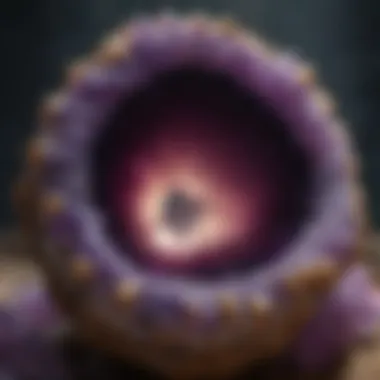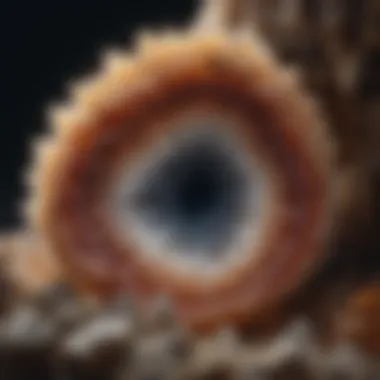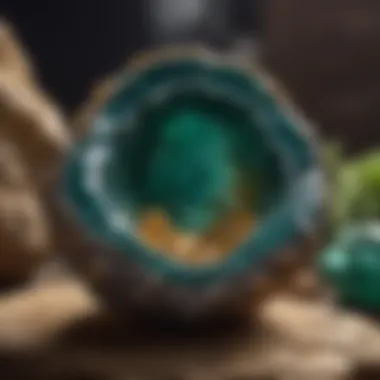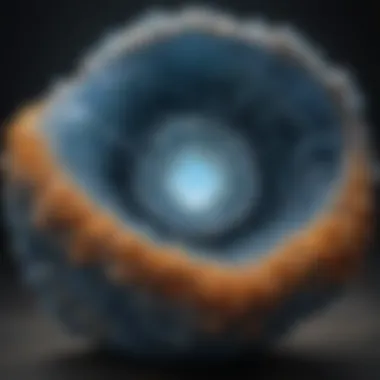Unveiling the Enigmatic Universe of Geodes: A Detailed Exploration of Varieties


Rock and Fossil Identification
Delving into the intriguing world of geodes requires a keen understanding of rock and fossil identification. Examining the various types of rocks and fossils present within geodes is essential for collectors and enthusiasts. From the crystalline structures of quartz to the vibrant coloring of agate, each type offers unique characteristics waiting to be explored. Tools such as magnifying glasses and scratch tests are paramount for accurate identification, ensuring a precise evaluation of the specimens.
Collecting Tips and Techniques
Unveiling the best practices for collecting geodes enhances the overall experience for enthusiasts. Locating prime collecting sites is a crucial step, as different types of geodes are found in specific geological regions. Understanding how to safely extract specimens from their natural habitat minimizes damage and preserves the integrity of the geode. By adhering to ethical collecting practices, enthusiasts can contribute to the sustainability of geode formations.
Preservation and Display
Preserving geodes involves delicate techniques to maintain their beauty and structural integrity. Utilizing methods such as cleaning with gentle brushes and storing in airtight containers helps prevent deterioration. Creative display ideas showcase the stunning beauty of geodes, whether through illuminated shelves or custom-made stands. Proper storage methods safeguard the specimens from environmental factors, ensuring their longevity and aesthetic appeal.
Geological Insights
Exploring the geological aspects of geodes unveils the intricate formations and processes that shape these natural wonders. Understanding the historical significance of rocks and fossils within geodes provides a window into the Earth's past. Notable discoveries in the field of geology offer insights into rare specimens and groundbreaking findings. By delving into the geological insights of geodes, enthusiasts gain a deeper appreciation for the natural forces that create these captivating formations.
Introduction
Geodes, the natural wonders hidden beneath dull exteriors, hold a mysterious allure that has captivated generations of rock and fossil enthusiasts. Their unassuming appearance conceals breathtaking crystal formations that spark curiosity and wonder. In this comprehensive guide, we delve into the mesmerizing realm of geodes, shedding light on their various types and formations found across the globe. Whether you are a seasoned collector or a novice enthusiast, exploring the world of geodes offers a fascinating journey through Earth's geological marvels.
Definition of Geodes
In the realm of geology, geodes represent geological creations formed within sedimentary and volcanic rocks. These spherical or oblong rock formations may appear unremarkable on the outside, but their true splendor lies within. Geodes are essentially cavities within rocks that contain internal crystal formations, such as quartz, amethyst, calcite, or celestite, formed over millions of years through a process of mineral-rich water depositing minerals in air pockets within the rock. They are often characterized by a hardened outer shell that, when cracked open, reveals stunning, intricate crystal structures that astound and mesmerize onlookers. Geodes vary in size, shape, color, and crystal composition, making each one a unique geological treasure waiting to be discovered.
Through the meticulous formation process, geodes acquire their distinctive features, making them highly sought after by collectors and geology enthusiasts worldwide. Rocks that at first glance may seem unremarkable become prized possessions when they house these natural works of art within their unassuming exteriors.
Exploring the definition of geodes unveils a world where simple rocks transform into geological masterpieces, offering a glimpse into the forces of nature that shape our planet over millennia.
Common Types of Geodes
In this article, the section dedicated to Common Types of Geodes holds significant importance as it serves as the foundation for understanding the various categories within the world of geodes. By discussing common types, readers can grasp the fundamental characteristics and features that are prevalent among different geodes. This section provides a comprehensive overview of some of the most widely encountered geodes, shedding light on their distinct qualities, potential benefits for collectors, and essential considerations to take into account when exploring these specimens.
Quartz Geodes
Quartz geodes are a fascinating category within the realm of geology, known for their stunning crystal formations and exceptional beauty. These geodes typically feature a hollow cavity lined with crystals, often quartz, amethyst, or calcite, creating intricate patterns that captivate enthusiasts. The unique properties of quartz geodes make them highly sought after in the collecting community, not only for their aesthetic appeal but also for their metaphysical properties believed to promote harmony and positive energy. Exploring the depth of quartz geodes unveils a world of beauty and wonder, showcasing nature's artistry at its finest.
Calcite Geodes


Calcite geodes are another intriguing variety that showcases the beauty and diversity of geodes. These geodes often contain calcite crystals, which exhibit a range of colors and formations, adding a vibrant touch to any collection. The formation process of calcite geodes involves intricate mineral deposits that result in unique patterns and structures, making each specimen a one-of-a-kind masterpiece. Collectors appreciate calcite geodes for their visual appeal and geological significance, as studying these formations provides insights into the earth's processes and history.
Celestite Geodes
Celestite geodes, characterized by their stunning blue crystals, offer a glimpse into the mesmerizing world of geodes. The celestial hue of celestite crystals evokes a sense of tranquility and serenity, making these geodes highly desirable among collectors. Beyond their visual allure, celestite geodes hold metaphysical properties that are believed to promote mental clarity and spiritual growth, adding a deeper dimension to their appeal. Exploring the depths of celestite geodes uncovers a peaceful sanctuary within the earth, inviting enthusiasts to contemplate the mysteries of the natural world.
Amethyst Geodes
Amethyst geodes are renowned for their deep purple crystals that radiate elegance and sophistication. These geodes are prized for their regal appearance and captivating beauty, making them a popular choice for collectors seeking unique and striking specimens. The varying shades of amethyst found within these geodes reflect nature's artistry, showcasing the interplay of light and color in a mesmerizing display. Delving into the world of amethyst geodes unveils a realm of luxury and enchantment, where each crystal tells a story of geological transformation and splendor.
Agate Geodes
Agate geodes present a kaleidoscope of colors and patterns that mesmerize collectors with their intricate designs and elegance. These geodes often feature banded agate formations that exhibit a range of hues, from earthy tones to vibrant shades, creating visually stimulating specimens that captivate the eye. The unique patterns and formations found in agate geodes make them prized possessions among collectors, as each piece offers a glimpse into the natural forces that shape our planet. Exploring the intricate details of agate geodes reveals a world of mesmerizing beauty and artistic complexity, enriching the collecting experience for enthusiasts.
Rare and Unique Geodes
Rare and unique geodes hold a special place within the realm of geology and gemology due to their exceptional characteristics and limited availability. In this article, the section on Rare and Unique Geodes aims to shed light on these extraordinary geological formations that intrigue collectors and enthusiasts. By focusing on specific elements, benefits, and considerations associated with rare and unique geodes, readers will gain a profound understanding of why these specimens are highly sought after.
Tabasco Geodes
Tabasco geodes, named after the region in Mexico where they are found, are renowned for their vibrant red and orange hues, making them stand out among other geode varieties. With a unique color palette and crystalline structures, Tabasco geodes are prized for their visual appeal and geological significance. This section delves into the formation process, characteristics, and significance of Tabasco geodes, providing readers with valuable insights into this captivating geological wonder.
Hollow Geodes
Among the rarest geode types are hollow geodes, distinguished by their empty interiors that once housed crystals or minerals. The geological processes that lead to the formation of these hollow cavities create intriguing patterns and structures, adding to their mystique. Exploring the enigmatic nature of hollow geodes, this section delves into their formation, characteristics, and the fascination they evoke among collectors and researchers.
Coconut Geodes
Coconut geodes, named for their resemblance to coconuts with a rough exterior that hides sparkling treasures within, are sought after for their unique aesthetics and geological features. This segment explores the distinctiveness of coconut geodes, highlighting their formation, crystal formations, and cultural significance. By unraveling the mysteries surrounding coconut geodes, readers will develop a deeper appreciation for these fascinating geological formations.
Keokuk Geodes
Keokuk geodes, originating from the Keokuk region in Iowa, are celebrated for their abundance of calcite crystals and intricate internal structures. Their varying sizes and aesthetic appeal make them highly desirable among collectors and enthusiasts. This section delves into the geological origins, characteristics, and collecting significance of Keokuk geodes, offering a comprehensive overview of their unique qualities and geological significance.
Empress of Uruguay
Geodes The Empress of Uruguay geode stands out as one of the largest amethyst geode specimens ever discovered, emanating grandeur and beauty. With its towering size and abundance of deep purple amethyst crystals, the Empress of Uruguay is a marvel of nature cherished by gem enthusiasts worldwide. By exploring the history, significance, and geological formation of the Empress of Uruguay geode, readers can grasp the magnificence of this rare and extraordinary geological wonder.


Geographical Variations in Geodes
Geographical variations play a crucial role in determining the types and quality of geodes found around the world. Understanding the geographical distribution of geodes is essential for collectors and enthusiasts as it provides insight into the specific conditions necessary for their formation. Different regions offer unique geological compositions that result in diverse geode types, each with its distinctive characteristics.
Exploring the geographical variations in geodes opens up a world of discovery, highlighting the impact of environmental factors on their formation. From mineral content to geological processes, each region contributes distinct features to the geodes found within its borders. By studying these variations, collectors can gain a deeper appreciation for the beauty and complexity of geodes from different parts of the globe.
Brazilian Geodes
Brazilian geodes are renowned for their stunning amethyst crystals, which can display vibrant hues of purple and violet. These geodes are commonly found in the southern region of Brazil, where volcanic activity and mineral-rich soil create optimal conditions for their formation. The amethyst geodes from Brazil are prized for their exceptional color and crystal quality, making them highly sought after by collectors worldwide.
Mexican Geodes
Mexican geodes are famous for their unique formations, often featuring intricate patterns and a variety of mineral inclusions. These geodes are predominantly found in the northern regions of Mexico, where volcanic activity and ancient geological processes have contributed to their mesmerizing structures. Mexican geodes come in an array of colors, ranging from clear quartz to deep blue celestite, adding to their allure and appeal among collectors.
Moroccan Geodes
Moroccan geodes are esteemed for their distinctive formations, characterized by intricate crystal patterns and brilliant coloration. These geodes are primarily found in regions like Er Rachidia and Boulemane, where the unique geological makeup has fostered the growth of stunning crystal clusters within the geodes. Moroccan geodes exhibit a diversity of mineral compositions, including quartz, calcite, and chalcedony, making them a treasure trove for collectors fascinated by geological diversity.
Australian Geodes
Australian geodes showcase a variety of crystal formations, with common types including quartz and agate geodes. These geodes are prevalent in regions such as Queensland and Victoria, where ancient volcanic activity and sedimentary processes have influenced their development. Australian geodes often exhibit intricate banding and vibrant colors, stemming from the diverse mineral content present in the region's geological formations.
Namibian Geodes
Namibian geodes are famed for their unique crystal formations and impressive size, often featuring sizeable quartz and calcite crystals. These geodes can be found in different regions of Namibia, where arid desert conditions and ancient geological activities have contributed to their formation. Namibian geodes stand out for their clarity and crystal transparency, creating mesmerizing displays that attract collectors interested in these geological marvels.
Formation and Characteristics of Geodes
In this comprehensive guide on the fascinating world of geodes, the
Significance of Geodes in the Collecting Community
In the intricate world of geology and mineral collecting, geodes hold a significant place, captivating the interest of collectors and enthusiasts worldwide. Their allure stems from a unique combination of geological processes that result in stunning crystal formations encapsulated within ordinary-looking rocks. Understanding the importance of geodes in the collecting community involves delving into several key elements that elevate their value and desirability.
Aesthetics and Rarity
The aesthetic beauty of geodes lies in the mesmerizing display of crystals within seemingly unassuming rock cavities. Collectors are drawn to the intricate patterns, vibrant colors, and dazzling formations found within these geological marvels. Each geode is a work of art crafted by nature over centuries, making them not only visually appealing but also rare and unique in their composition. The rarity of certain geode types adds an element of exclusivity to collectors' pursuits, driving the passion for acquiring these geological treasures.


Educational Value of Geodes
Beyond their visual appeal, geodes offer significant educational value to collectors, students, and researchers interested in geology and earth sciences. Studying geodes provides insights into geological processes such as sedimentation, mineralization, and crystal growth. By examining the internal structures and crystal formations within geodes, enthusiasts can learn about the conditions that led to their formation and the geological history of the region where they were found. Geodes serve as valuable teaching tools that help individuals deepen their understanding of geological principles and appreciate the wonders of the natural world.
Cultural and Historical Relevance
Geodes hold cultural and historical significance in various societies across the globe. In many ancient cultures, geodes were revered for their mystical properties and believed to possess spiritual energies or healing powers. The use of geodes in religious ceremonies, artistic expressions, and traditional medicine reflects their cultural importance throughout history. Furthermore, the discovery and collection of geodes have played a role in shaping scientific inquiries and exploration, contributing to the rich tapestry of human knowledge and discovery.
Market Value and Trading
The market value of geodes fluctuates based on factors such as rarity, size, quality of crystals, and geographical origin. Collectors and traders engage in buying, selling, and trading geodes as part of a vibrant market that caters to enthusiasts worldwide. Auction houses, online platforms, and mineral shows often showcase coveted geode specimens that command high prices due to their exceptional beauty or scarcity. Understanding the market dynamics of geodes allows collectors to navigate the trading community, discover valuable pieces for their collections, and appreciate the financial aspects of mineral collecting.
This comprehensive guide to the significance of geodes in the collecting community explores the multifaceted appeal of these natural wonders, highlighting their aesthetic, educational, cultural, and economic relevance to enthusiasts passionate about earth sciences and mineral exploration.
Preservation and Display of Geodes
The section on Preservation and Display of Geodes is crucial in this comprehensive guide as it sheds light on how to maintain and showcase these natural wonders effectively. Preserving geodes is essential to retain their beauty and value over time. Proper preservation not only ensures their longevity but also safeguards them from damage and deterioration. Displaying geodes, on the other hand, allows enthusiasts to appreciate their unique aesthetics and geological formations. It offers an opportunity to showcase these marvels to others, sparking curiosity and admiration among viewers.
Cleaning and Maintenance Tips
Cleaning and maintaining geodes require meticulous attention to detail to ensure their pristine condition. To clean geodes, gently rinse them with lukewarm water and a soft brush to remove dirt or debris. Avoid using harsh chemicals or abrasive materials that may scratch or damage the surface. Regular maintenance involves inspecting geodes for any signs of wear or erosion, addressing any issues promptly to prevent further damage.
Display Techniques for Geode Collections
Effective display techniques are vital to highlight the beauty and uniqueness of geode collections. Arrange geodes creatively, considering factors like size, color, and crystal formations. Display them in well-lit areas to accentuate their natural shimmer and intricacies. Utilize stands or mounting devices to showcase geodes at varying heights for visual interest. Experiment with different display layouts to create eye-catching arrangements that capture and hold attention.
Storing Geodes Properly
Proper storage practices are paramount to protect geodes from environmental factors that can impact their integrity. Store geodes in a cool, dry place away from direct sunlight to prevent discoloration or fading. Use soft padding or individual compartments to prevent scratching or chipping during storage. Avoid placing heavy objects on top of geodes or stacking them in a way that may cause pressure or breakage. By following these storage guidelines, collectors can ensure the longevity and preservation of their prized geode specimens.
Conclusion
In the vast world of geodes, the conclusion serves as a pivotal point in synthesizing the myriad information presented throughout this comprehensive guide. By tracing back to the various types of geodes discussed, ranging from common quartz and calcite geodes to the rare and unique Tabasco and Coconut geodes, we can appreciate the sheer diversity and beauty that Mother Nature unfolds before us. The importance of this conclusion lies in its ability to encapsulate the wonder and fascination that geodes evoke in collectors and enthusiasts worldwide.
Undoubtedly, the significance of geodes extends beyond mere geological formations; they represent a connection to the Earth's history, a visual feast for the eyes, and a source of endless wonderment. Through understanding the formation processes, internal structures, and crystal formations within geodes, collectors gain a deeper appreciation for the intricate beauty that lies within these seemingly ordinary rocks. Moreover, the discussion on the preservation and display techniques underscores the value placed on these natural treasures.
The uniqueness of geodes lies not only in their physical properties but also in their ability to spark curiosity, ignite passion, and bridge the gap between science and art. As we delve into the depths of geodes, we unveil a world brimming with awe-inspiring formations that challenge our perceptions and enrich our understanding of the natural world. Embracing the diversity of geodes allows us to appreciate the marvels of geological processes and the sheer magnificence of Earth's creations.
Appreciating the Diversity of Geodes
As we embark on a journey through the fascinating world of geodes, one cannot help but be mesmerized by the sheer diversity and beauty that these geological wonders possess. Each type of geode, whether common like quartz or rare like Tabasco geodes, offers a unique glimpse into the intricate workings of the Earth's processes and the stunning variations that result from different environmental conditions.
Appreciating the diversity of geodes goes beyond mere visual appeal; it involves delving into the geological history encapsulated within these exquisite rocks. From the geological processes that create these formations to the internal structures that house intricate crystal formations, each aspect showcases the complexity and magnificence of geodes.
Furthermore, understanding the significance of geodes in the collecting community sheds light on their value beyond monetary worth. Geodes serve as educational tools, cultural artifacts, and historical pieces that bridge the gap between the past and the present. Their market value and trading significance underscore their desirability and the passion they evoke among collectors.







